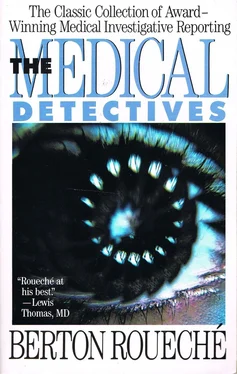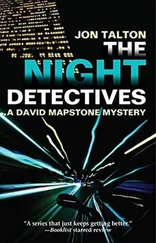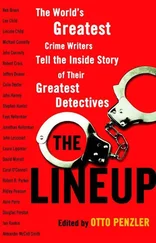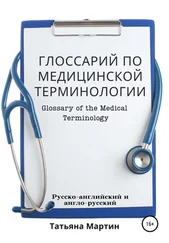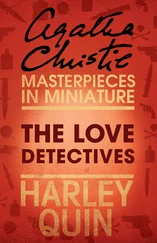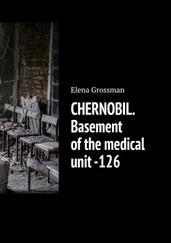"That was interesting," Dr. McMillin told me, "but I wasn't too impressed. People are always calling to tell about a cluster of some disease or other. It usually turns out that there is a confusion of diagnoses. Besides, I told Jacobson, thyrotoxicosis isn't a disease that occurs in epidemic form. It isn't a communicable disease, like measles or influenza. The only outbreak of thyrotoxicosis on record in this country that might be called an epidemic occurred back in the twenties, when iodinated salt was first introduced. It brought on a lot of Graves' disease in susceptible people. Jacobson said something like 'Well, maybe so. But one of those four people is my own mother.' I still wasn't much impressed. And then, that night, something strange happened. I had brought back from Baltimore a number of abstracts of papers to be given later in the meeting, and I was leafing through them at home. I had a grand rounds to present the next day, and I thought I might pick up something new and interesting to add to my presentation. And lo and behold! My eye caught a title—'Painless Thyroiditis: A Community Outbreak in Nebraska.' The outbreak occurred between January and March of 1984 in a seven-county area of southeastern Nebraska, and it numbered fifty-four cases, most of them in the county of York. There was no thyroid enlargement or tenderness. There were no deaths, but six patients were hospitalized. The ages ranged from six to eighty-two. The outbreak ended as mysteriously as it had begun, and the cause was never determined. Well, I could hardly believe it. Now I really was impressed. If it could happen in Nebraska, it could happen here. The minute I finished my grand rounds the next morning, I went over to the Nuclear Medicine Department at McKennan Hospital and looked through the logbook of procedures. Sure enough, there had been a recent increase in thyroid studies, with results pointing to thyroiditis. Some of them were even my own patients. They came from various places: Valley Springs, of course, and several towns or villages just across the line in Minnesota—Beaver Creek, Hills, and Luverne, a town of around five thousand. I checked with Sioux Valley Hospital, and the logbook there showed much the same picture. Oddly, none of the cases were here in Sioux Falls, and Sioux Falls is the largest city by far in a rather large surrounding area in South Dakota, Minnesota, and Iowa. 1 arranged for a list of all the names and addresses, and drove back to my office and got out that Nebraska abstract. It gave a list of the participating investigators. Most of them were from the Centers for Disease Control, in Atlanta. I called them, one by one, and they were all out of the office. I left my name and telephone number, and waited. I had to think that I was really onto something.
"You know how it is when you're waiting for a particular call. The phone keeps ringing, but it's never the call you're waiting for. Then—at last. It was a young doctor named Daniel B. Fishbein.
He had been at C.D.C. for a number of years, and his major work there was in rabies, but, yes, he had been to York and was still very much interested in that unresolved outbreak. I told him what seemed to be happening here. He said the feeling of the team at York was that the cause was probably a viral illness. A good many of the thyroiditis patients reported an earlier upper-respiratory infection. I told him that that was what I had in mind in our problem here. I asked him if he would be interested in giving me a hand. He was—very much so. But C.D.C. is a federal agency, and there is a very strict protocol governing its investigations. It can come into a state only upon invitation from the state. Fishbein said he would sound out C.D.C. and the South Dakota Health Department. We arranged for the invitation, and Fishbein—or Dan, as I came to know him—got permission from his people. I gave him everything I had—names, addresses, and study results. We set a date: June 15.
"Meanwhile, I got a call from Jim Felker, asking me for a consultation on Jacobson's mother. She was hospitalized at McKennan. I went to see her. She was very definitely thyrotoxic. She had all the symptoms, and very high blood levels of circulating thyroid hormones. But she also confused things. Her thyroid gland was enlarged. That was atypical of this outbreak. And she had a previous history of thyroid disease—she had a goiter and had been on thyroid-hormone therapy for some years. Her thyroid gland should have been anything but enlarged. That enlargement suggested that something was stimulating it. I began to wonder if I was dealing with a genetic problem—a genetic susceptibility. Mrs. Jacobson had her own house. She didn't live with her son. But they both had what looked like the same illness. On the other hand, that hardly explained the other cases.
"Well, Dan Fishbein arrived. He had with him an enthusiastic assistant—a young woman medical student named Janet Farhie. She was working at C.D.C. as an interne. Dan was originally from California—from Hollywood, no less! She was from upstate New York. Dan and Jan—as they came to be—had with them another helper: a copy of 'The Thyroid,' by Drs. Sidney Ingbar and Lewis Braverman, the standard text in the field. They had been giving themselves a crash course in endocrinology. But they had something valuable that I didn't have. Dan was trained in epidemiology, with years of experience, and she was learning. They moved into the Holiday Inn here, and we got down to work. We agreed, at least for the moment, that what we seemed to be seeing here was the same as the York outbreak. The fact that the York County outbreak ended so abruptly and inconclusively gave us a sense of urgency. We didn't want to be left dangling here. And our outbreak was growing pretty fast. By the time Dan and Jan arrived, the reports I was getting indicated that we had at least a dozen cases. The first step in an investigation of this sort is to set up what is called the case definition. We had to establish the criteria. We set two grounds for inclusion. Cases were defined as patients with two or more symptoms of thyrotoxicosis and with concentrations of thyroid hormone in the blood at least twenty-five per cent greater than the upper limit of normal established at the testing laboratory. Patients with a previous history of thyroid disease, of course, were excluded. Then, because of the cases that were appearing across the line in Minnesota, there was another matter of protocol. That, too, was arranged, and as it soon became clear that most of the new cases were occurring in Minnesota, the administrative leadership of the investigation was taken over by the Minnesota Department of Health, in Minneapolis. Craig W. Hedberg and Michael T. Osterholm were the department people in charge, and some others came in later. But at this stage, at least, much of the real work, the legwork, devolved on Dan and Jan.
"At about that time, I had to leave town again. I'm on the national board of directors of the American Cancer Society, and there was a meeting scheduled for the third week of June, out in California, in Beverly Hills, and I was committed to attend. I was sorry about that, but Dan and Jan were well set up to manage on their own. Everything was falling into place. We had our case definition. The next step was to visit the identified cases and interview them about the nature and onset of symptoms and take blood and other samples. Dan and Jan were both, in their jargon, experienced vampires. The samples were to be divided—half to be frozen for highly sophisticated viral studies, if necessary, at the C.D.C. laboratories. The lab work on the other half was to be done here in Sioux Falls by Dr. Mary Jo Jaqua, a microbiologist at the medical school and the V.A. Medical Center. Our feeling was that we were dealing with a viral outbreak, and Dr. Jaqua was to culture the specimens for that. Another aspect of the epidemiological study was, of course, to establish the geography of the outbreak.
Читать дальше
